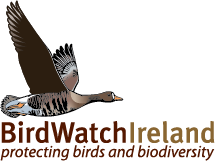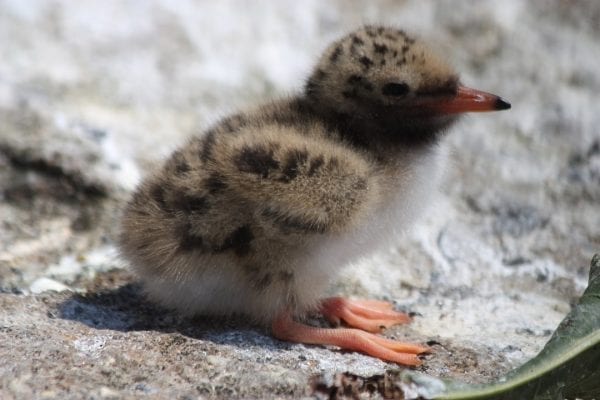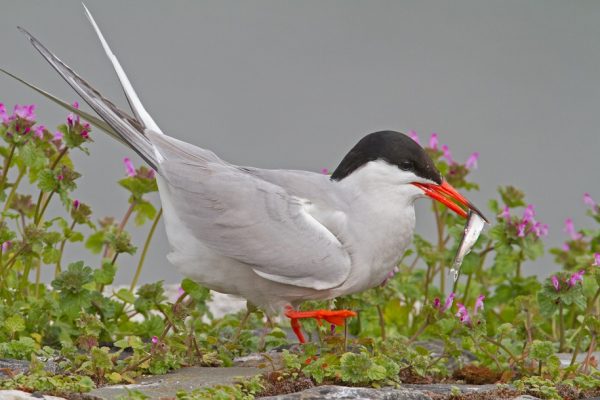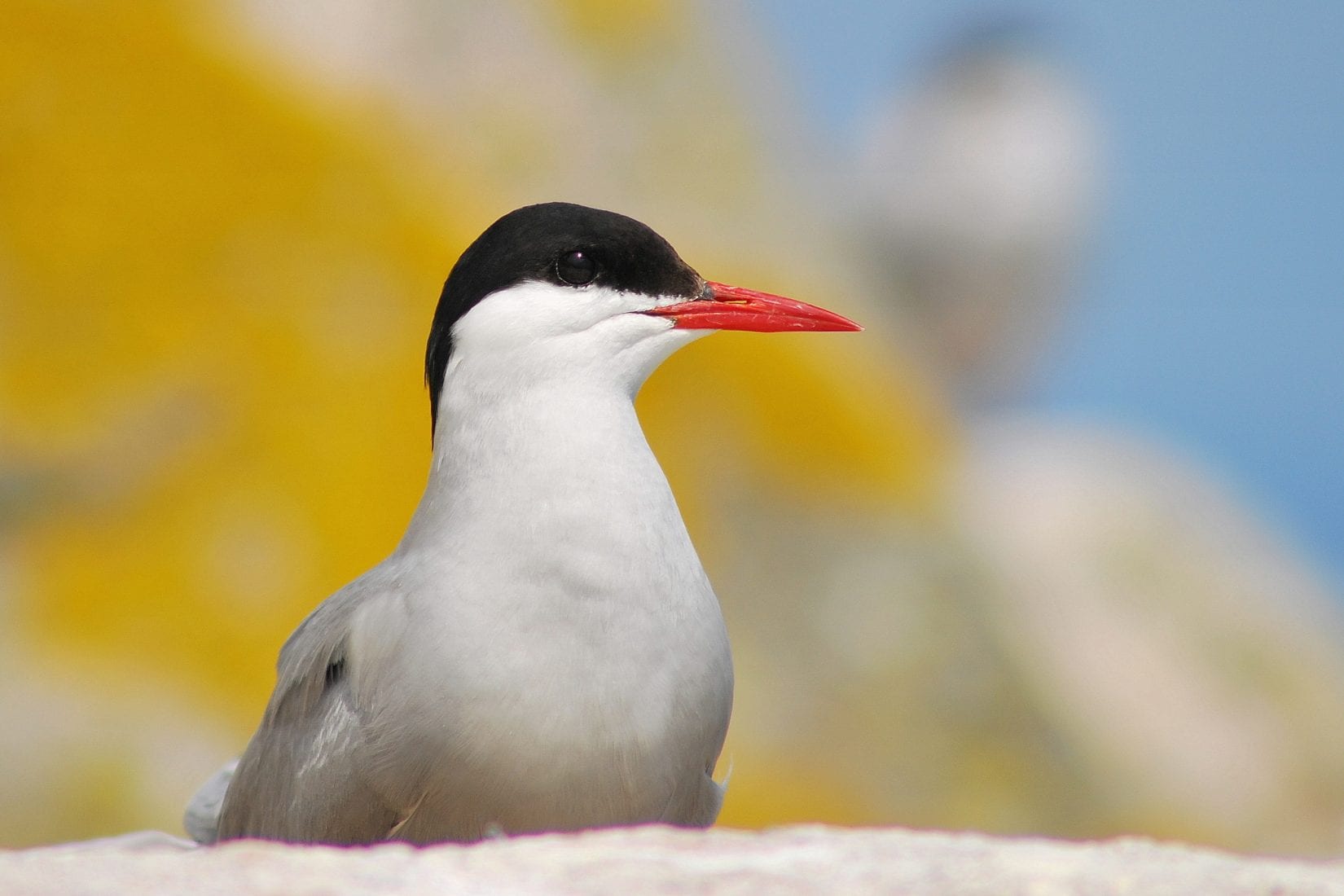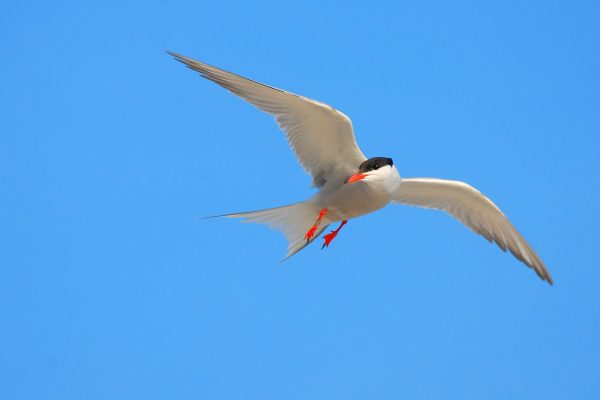
Common Tern
| Irish Name: | Geabhróg |
| Scientific name: | Sterna hirundo |
| Bird Family: | Terns |
amber
Conservation status
Conservation status
Status
Summer visitor from March to October to all Irish coasts.
Identification
Usually seen over the sea or over large inland lakes. Slender seabird with narrow, pointed wings, long forked tail and long, pointed bill. Grey above and white below, dark cap to head. Flight light and buoyant, can hover briefly over the sea before diving in. Very similar to Artic Tern (with which it breeds) and told apart by plumage and structure. Common Tern has a longer head and bill and slightly broader wings, which look central on the body. Adults have a orangey red bill, usually with a small dark tip. Underparts are whiter than Artic Tern and there is no contrast with cheek. The wing pattern is useful in separation, Common tern shows a dark wedge in the primaries which develops over the summer and a defuse bar to the trailing edge of the primaries. Common terns have shorter tail steamers, not extending beyond the wing tips. Adult winter plumage, like all terns is different from breeding plumage and can develop in the summer months. Has a white forehead, all dark bill and dark carpel bar. Also has distinctive juvenile plumage with gingery mantle, a dark secondary bar and dark carpel bar. Bill base is orange. Shows a diffuse trailing edge to the primaries. First and second summer plumages are rarely seen in Europe.
Voice
A noisy bird when breeding, giving a rapid series of quarrelsome calls.
Diet
Chiefly fish.
Breeding
Nest colonially on the ground from August to October. Breeds on the coast, with larger colonies in Co. Dublin, Co. Wexford and Co. Galway. Also breeds inland on islets in freshwater lakes, notably in Co. Galway and in Co. Mayo.
Wintering
Winters in west and south Africa.
Monitored by
All-Ireland Tern Survey in 1995, and through breeding seabird surveys carried out every 15-20 years. Common Terns are also monitored annually at Rockabill and Lady’s Island Lake.
Blog posts about this bird

A Summer evening on Sandymount Strand
Over the summer we have been working in Dublin Port on our tern conservation project, funded by the Dublin Port Company. This project focuses on the Common and Arctic tern populations that breed within the Port area. Both Common and Arctic Terns are ‘Amber- listed’ species in Ireland - meaning they are of ‘medium conservation concern’ - and the colony that nests within Dublin Port is the third largest in the Republic of Ireland.
Terns have the longest migration of any animal. Arctic Terns, as their name might suggest, have a breeding range that extends up to the Arctic circle during our summer, before migrating down to their feeding grounds in Antarctica during our winter. Though Common Terns don’t migrate as far as this, with Irish- breeding Common Terns migrating down as far as the west coast of Africa during our winter, it is still an impressive distance to travel for a bird that doesn’t weigh much more than 100g.
Part of the work we do to monitor and protect terns in the port involves the ringing of chicks and adults,. This is when we add uniquely coded metal and colour ID rings to individual birds so that we can identify them. This work helps us to assess survival rates, site fidelity (i.e. do individuals return to the same place to breed every year, or do they move elsewhere), as well as to identify migration routes when birds are resighted travelling to and from their breeding grounds.






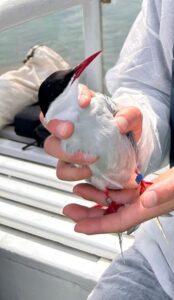
(Above: Arctic Tern fitted with metal and colour ID rings, under BTO and NPWS licence)
Over the summer, most of our ringing work has focused on tern chicks - if you follow us on social media, you may already have seen some of our posts relating to this (and if you haven’t, go ahead and give us a follow to keep updated on our important information, including many cute pictures of birds – links at the bottom of this article). However, as summer draws to an end, and the chicks start to fledge and join the adults to begin their long migration south, we change tactics with the aim of capturing adults rather than chicks. To do this, we set up mist nests near their evening roost sites. You can see how this looks in the photos below (just!!). It’s a task easier said than done. It requires the right tides to align with the right time and because of this we usually only get one opportunity a year to ring adult and fledgling terns in this way, so it is an exciting opportunity whenever it arises. And luckily, this year did not disappoint!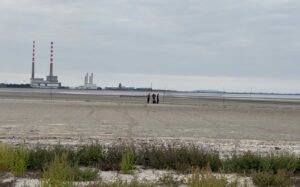
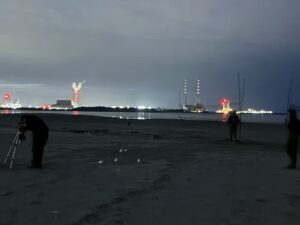
(Above 1 & 2, the team setting up the mist nets in the fading light over Dublin Bay)
We caught not only terns, but also Oystercatchers, Redshanks, Turnstones and even a Black-tailed Godwit! With over 60 birds captured, we caught more birds this year than in the previous five put together. A fantastic day for us which offers us an opportunity to learn much more about these birds in the years to come. And while that will be the last of the terns we catch this summer as they migrate away, it will hopefully be the first of the waders as they make their way to overwinter in Ireland.
(Above: a night vision scope used to see when a bird has been caught in the net)
The highlights of this mammoth haul include; a Common Tern that was ringed in Senegal whilst migrating northwards in the spring, offering us an insight into the migration paths that our Common Terns take; and we had a resighting of a Common Tern that was ringed in 2010., For a species that lives on average to around 10 years old, a resighting of a 15-year-old is pretty special; we colour- ringed three Turnstones, which is part of a new project on this species and so we are delighted to be able to ring these for the first time; and we also had a resighting of an Oystercatcher, which helps build our knowledge on the site fidelity of this species and their migration routes between their summer breeding and winter feeding grounds. All in all, it was a great night s outing for us and we will be keeping everything crossed for the same again next year! Until then, follow us on Facebook, Instagram and X for updates on all of our ongoing work. If you would like to support us and to make a direct contribution to the protection of Ireland’s birds and biodiversity, please do so by becoming a member here and signing up for our members only newsletter, Wings, alongside many more members only benefits.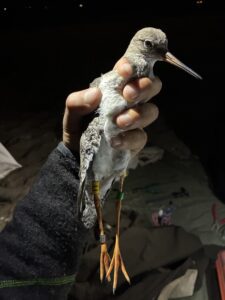
(Above: Redshank fitted with metal and colour ID rings)
All photos taken under NPWS license and all handling and ringing is done by trained and licensed bird ringers. The Dublin Bay Birds Project is funded by

Ups and Downs for Galway Terns in 2025
[vc_row type="in_container" full_screen_row_position="middle" column_margin="default" column_direction="default" column_direction_tablet="default" column_direction_phone="default" scene_position="center" text_color="dark" text_align="left" row_border_radius="none" row_border_radius_applies="bg" overflow="visible" overlay_strength="0.3" gradient_direction="left_to_right" shape_divider_position="bottom" bg_image_animation="none"][vc_column column_padding="no-extra-padding" column_padding_tablet="inherit" column_padding_phone="inherit" column_padding_position="all" column_element_direction_desktop="default" column_element_spacing="default" desktop_text_alignment="default" tablet_text_alignment="default" phone_text_alignment="default" background_color_opacity="1" background_hover_color_opacity="1" column_backdrop_filter="none" column_shadow="none" column_border_radius="none" column_link_target="_self" column_position="default" gradient_direction="left_to_right" overlay_strength="0.3" width="1/1" tablet_width_inherit="default" animation_type="default" bg_image_animation="none" border_type="simple" column_border_width="none" column_border_style="solid"][vc_column_text css="" text_direction="default"] For the past six years, Conservation Volunteers Galway and staff at the Atlantic Technological University have been protecting and monitoring nesting Common Terns in Galway City, to great success. The team have installed three rafts in Lough Atalia, designed to provide safe nesting habitat as an alternative to local sites that are subject to disturbance and predation. In recent years we have been delighted to be invited to assist them in their work by ringing the Terns so that we can find out more about them – their survival rates, where they go after leaving Galway, what other colonies they're linked to, and more. This year the ringing work has been co-funded by Galway City Council and the National Parks and Wildlife Service under the Local Biodiversity Action Fund and we are very grateful to them for making this work possible.
For the past six years, Conservation Volunteers Galway and staff at the Atlantic Technological University have been protecting and monitoring nesting Common Terns in Galway City, to great success. The team have installed three rafts in Lough Atalia, designed to provide safe nesting habitat as an alternative to local sites that are subject to disturbance and predation. In recent years we have been delighted to be invited to assist them in their work by ringing the Terns so that we can find out more about them – their survival rates, where they go after leaving Galway, what other colonies they're linked to, and more. This year the ringing work has been co-funded by Galway City Council and the National Parks and Wildlife Service under the Local Biodiversity Action Fund and we are very grateful to them for making this work possible.
 From early May we had reports from Peter, Dan (Conservation Volunteers Galway) and Ian (ATU) that the Terns were back and nesting on the artificial floating platforms they’ve been deploying annually in Lough Atalia, beside Galway City. Each platform has UV protected clear polycarbonate walls to keep out any predators that might swim out, and though there are gulls in the area and they occasionally land on the platforms, the Terns do a good job of seeing them off once they return in late April.
From early May we had reports from Peter, Dan (Conservation Volunteers Galway) and Ian (ATU) that the Terns were back and nesting on the artificial floating platforms they’ve been deploying annually in Lough Atalia, beside Galway City. Each platform has UV protected clear polycarbonate walls to keep out any predators that might swim out, and though there are gulls in the area and they occasionally land on the platforms, the Terns do a good job of seeing them off once they return in late April.



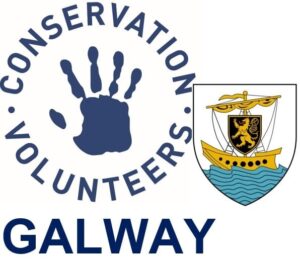 For the past six years, Conservation Volunteers Galway and staff at the Atlantic Technological University have been protecting and monitoring nesting Common Terns in Galway City, to great success. The team have installed three rafts in Lough Atalia, designed to provide safe nesting habitat as an alternative to local sites that are subject to disturbance and predation. In recent years we have been delighted to be invited to assist them in their work by ringing the Terns so that we can find out more about them – their survival rates, where they go after leaving Galway, what other colonies they're linked to, and more. This year the ringing work has been co-funded by Galway City Council and the National Parks and Wildlife Service under the Local Biodiversity Action Fund and we are very grateful to them for making this work possible.
For the past six years, Conservation Volunteers Galway and staff at the Atlantic Technological University have been protecting and monitoring nesting Common Terns in Galway City, to great success. The team have installed three rafts in Lough Atalia, designed to provide safe nesting habitat as an alternative to local sites that are subject to disturbance and predation. In recent years we have been delighted to be invited to assist them in their work by ringing the Terns so that we can find out more about them – their survival rates, where they go after leaving Galway, what other colonies they're linked to, and more. This year the ringing work has been co-funded by Galway City Council and the National Parks and Wildlife Service under the Local Biodiversity Action Fund and we are very grateful to them for making this work possible.
 From early May we had reports from Peter, Dan (Conservation Volunteers Galway) and Ian (ATU) that the Terns were back and nesting on the artificial floating platforms they’ve been deploying annually in Lough Atalia, beside Galway City. Each platform has UV protected clear polycarbonate walls to keep out any predators that might swim out, and though there are gulls in the area and they occasionally land on the platforms, the Terns do a good job of seeing them off once they return in late April.
From early May we had reports from Peter, Dan (Conservation Volunteers Galway) and Ian (ATU) that the Terns were back and nesting on the artificial floating platforms they’ve been deploying annually in Lough Atalia, beside Galway City. Each platform has UV protected clear polycarbonate walls to keep out any predators that might swim out, and though there are gulls in the area and they occasionally land on the platforms, the Terns do a good job of seeing them off once they return in late April.

One of the artificial pontoons deployed in Lough Atalia to ensure Common Terns have somewhere safe and reliable to nest. Photo: Brian Burke.
Our first ringing visit took place in late May when most Common Tern pairs were more than halfway through the incubation period for their eggs. This was our first time to ring adult Terns in Galway. Small cage traps were carefully placed over nests, the ringing team moved away on the boat, and returned around 15 minutes later to take the birds out, ring them and quickly release them so they can go back to incubating their clutch again. BirdWatch Ireland do this sort of ringing at other colonies including Rockabill Island and Dublin Port to great success. While ringing chicks is useful and informative, it takes a few years for the chicks to return to the colony, whereas by ringing adults you can start to gather data much more quickly. We are hoping this ringing project will help us learn about the survival rates of the Galway Common Terns, their fidelity to the same platform and nest site, links with other colonies, as well as sites they use on their migration. We are using green colour rings with three numbers beginning with ‘6’ and a full stop, and these rings are also being used on Common Terns on Lough Ree in a project with the National Parks and Wildlife Service there, and will possibly be used at other sites in the west in the years to come.
One of the Common Terns nesting at Lough Atalia - caught and ringed under NPWS licence, and quickly released to return to the colony. The green coded ring is visible from a distance and will help us identify this individual in the future. Photo: Brian Burke.
In total we caught 14 adult Common Terns on this trip, almost all of which were not previously ringed, though the final bird of the day was sporting a metal BTO ring on its left leg. We added one of our colour rings so this bird can be more easily monitored in the future, and then very quickly sent the ring number off to the BTO to find out where and when it had come from! We were able to quickly check that it wasn’t from any of the NPWS or BirdWatch Ireland tern ringing projects on the east coast, and the chances of it being a Galway bird seemed slim even though a small number of tern chicks had been ringed in Galway in recent years. It turns out this bird was originally ringed as a chick in July 2006, making it 19 years old! While Common Terns can live to their late 20’s, the vast majority are under 10 years old. If they survive beyond that they’re doing well, and to reach nearly 20 years old is fantastic! This individual was ringed in Cork Harbour as a chick – another colony on artificial structures in an urban port area. For context, the oldest Common Tern on record in Ireland was 23 years old.
This Common Tern, nesting in Lough Atalia in Galway in 2025, was originally ringed as a chick in Cork Harbour in 2006, making it 19-years old. Photo: Emily Marsh.
Conservation efforts at individual colonies like Lough Atalia, Cork Harbour, Dublin Port, Rockabill, Lady's Island and elsewhere not only benefit that specific colony, but ensure there are more juvenile birds to spread to and help bolster and grow other sensitive colonies in other areas. Catching this bird was the icing on the cake of a successful day. The total number of nests present on this visit was 42 which was a very healthy number and really speaks to the success of this project by Galway Conservation Volunteers. The first chicks started hatching in the last week of May and our intention was to make another visit to ring the chicks in late June before they fledged. Unfortunately the team in Galway reported that the colony was hit by what was suspected to be avian flu shortly after, resulting in the loss of almost all chicks, and many adults. This outbreak has been devastating for the project team at Conservation Volunteers Galway, Atlantic Technological University and us at BirdWatch Ireland. This colony was hit by avian flu in 2023 alongside many other tern and gull colonies in Ireland and the UK, thankfully in 2024 there was no sign of avian influenza at the colony and an estimated 60 chicks fledged. Despite the negative end to this season, we shouldn’t forget how successful this project has been to date. Terns had struggled to nest successfully in inner Galway Bay due to predation and disturbance, and these platforms provided them with somewhere safe and reliable to nest. All we can hope now is that enough adults abandoned the colony without having caught avian flu and will survive to return next year. There will also be some young birds born here in recent years who are not yet old enough to breed, that will hopefully return in 2026 and beyond. The spread and impacts of avian flu only further underscore the importance of conservation projects like this, and we hope through continued ringing studies we can better evaluate the linkages between colonies to learn about the spread of avian flu and the hopeful recovery of the Common Tern population.The Common Tern colour-ringing project at at Lough Atalia is co-funded by Galway City Council and the National Parks and Wildlife Service under the Local Biodiversity Action Fund. A special thanks to Galway City Biodiversity Officer Paula Kearney for her help and support with the project and to Emily Marsh for assistance with ringing.
Funding for the Lough Atalia Tern Conservation Project, by Conservation Volunteers Galway, has been provided by Atlantic Technological University, The Heritage Council, Galway Atlantaquaria, Galway City Tidy Towns and public donations.
[/vc_column_text][/vc_column][/vc_row][vc_row type="in_container" full_screen_row_position="middle" column_margin="default" column_direction="default" column_direction_tablet="default" column_direction_phone="default" scene_position="center" text_color="dark" text_align="left" row_border_radius="none" row_border_radius_applies="bg" overflow="visible" overlay_strength="0.3" gradient_direction="left_to_right" shape_divider_position="bottom" bg_image_animation="none"][vc_column column_padding="no-extra-padding" column_padding_tablet="inherit" column_padding_phone="inherit" column_padding_position="all" column_element_direction_desktop="default" column_element_spacing="default" desktop_text_alignment="default" tablet_text_alignment="default" phone_text_alignment="default" background_color_opacity="1" background_hover_color_opacity="1" column_backdrop_filter="none" column_shadow="none" column_border_radius="none" column_link_target="_self" column_position="default" gradient_direction="left_to_right" overlay_strength="0.3" width="1/1" tablet_width_inherit="default" animation_type="default" bg_image_animation="none" border_type="simple" column_border_width="none" column_border_style="solid"][vc_column_text] [/vc_column_text][/vc_column][/vc_row]